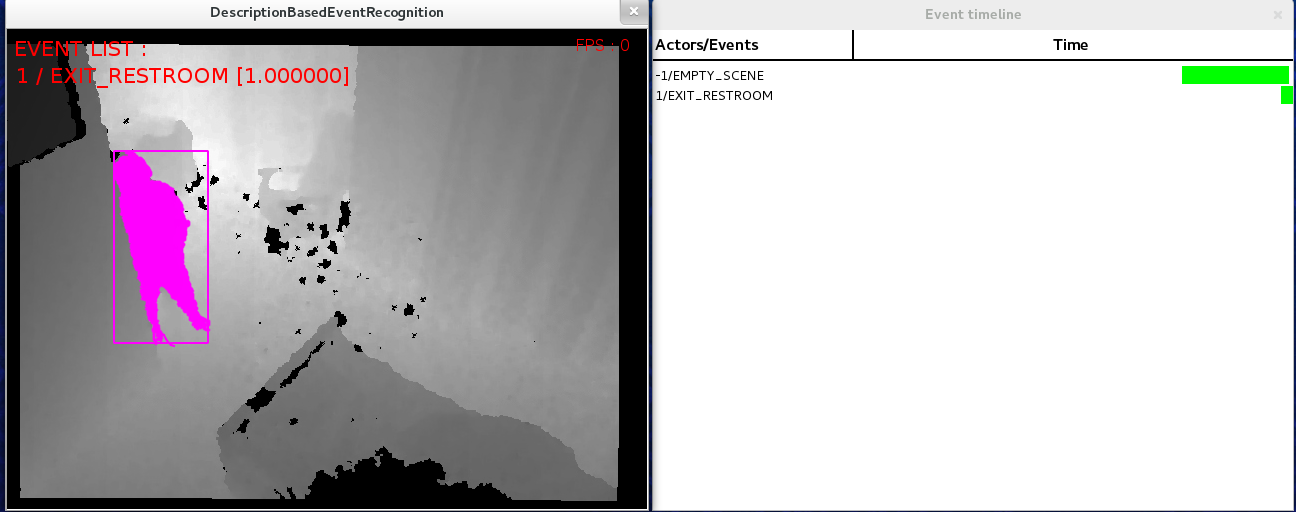Section: New Results
Evaluation of an Event Detection Framework for Older People Monitoring: from Minute to Hour-scale Monitoring and Patients Autonomy and Dementia Assessment
Participants : Carlos F. Crispim-Junior, Alvaro Gomez Uria Covella, Carola Strumia, Baptiste Fosty, Duc Phu Chau, Anh-Tuan Nghiem, Alexandra Konig, Auriane Gros, Philippe Robert, François Brémond.
keywords: RGBD cameras, description-based activity recognition, older people,
Two main works are reported here: the continuous evaluation and extention of our event detection framework for older people monitoring, and the proposal of a behavioral classification model for the assessment of autonomy and cognitive health level of older people using automatically detected events. The evaluation of our event monitoring framework was extended from 29 to 49 recordings of senior participants undertaking physical tasks (7 min per participant, total : 5.71 hours) and instrumental activities of daily living (IADL, 15 minutes per participant, total: 12.25 hours). The recordings have taken place in a ecological observation room set in the Memory Center of Nice hospital. In the extended evaluation we employed a RGBD sensor as input instead of a standard RGB camera due to its advantages like invariance to illumination changes and real-time measurements of 3D information which foster better performance of the underlying algorithms for people detection and tracking. Table 6 presents the event monitoring performance of the present system for 49 participants. Event detection performance on physical task generalized to the larger dataset with a small performance increase of 1.4% (average F-Score). Concerning IADL detection although the global performance value (F-Score, 80.7 %) are the same, the new approach have made a trade-off between recall and precision to obtain more reliable detection of activities and their parameter estimations. Low precision values on preparing drink (e.g., making coffee) and watering plant are due to these activities being performed in very close - if not overlapping - locations (contextual zones). Low precision values in reading are due to the preferred reading location be close to image edges where most parts of person body are frequently outside the camera field of view.
Using the event monitoring system as input we have devised a behavioral classification model for the automatic assessment of participant cognitive health and autonomy level. Besides to event data the model also uses fine-grained data about person gait attributes (e.g., stride-length, cadence, etc), obtained by a RGBD-based algorithm for gait analysis also developed in STARS team. Briefly, the event monitoring system supports the doctor by automatically annotating the patient daily living activities and assessing his/her gait parameters in a quantitative way, and the behavioral model performs the classification of participant's dementia and autonomy levels as a complement for standard psychometric scales for autonomy. We achieved an average accuracy of 83.67 % at the prediction of patient autonomy (poor, mediocre, good), and of 73.46 % for cognitive level class (healhy, memory cognitive impairment - MCI, alzheimer's disease), all models using a Naíve Bayes classifier. The results suggest that the behavioral classification model using automatically detected events outperforms the same model using events manually annotated by domain experts (81 %). On the contrary, the model using annotated data still outperforms the automated detection at dementia classification (79.46 %). Results indicate it is easier to predict the autonomy level than the Dementia, since the latter may be seen as the cause /source and the first its consequences. Deciding whether a decay on cognitive abilities relates to normal aging or early MCI or a given mild cognitive decay is an early symptom of Alzheimer's diasease or a severe case of MCI is also a open-problem for medical community. Future work will focus on investigating whether the remaining performance to achieve is related to the performance failures of the underling event monitoring system, to important behavioral aspects still not covered by the behavioral model, or even to the inherently ambiguous nature of the dementia classes.
| Physical Tasks | Recall | Precision |
| Single Task | 100% | 88% |
| Dual Task | 100% | 98% |
| IADLs | Recall | Precision |
| Preparing drug box | 87% | 93% |
| Watering plant | 80% | 63% |
| Reading | 60% | 88% |
| Prepare drink | 90% | 68% |
| Talk on phone | 89% | 89% |
We have also started the evaluation of the event monitoring system in Nursing home scenario passing from a minute time-scale to hours. A first participant was monitored with two RGBD sensors, one for bed-related events (sleep, bed exits) and one for living room and daily living activity events for 14 days. Preliminary results are 80 % for entering in bed and 100 % for bed exit in set of 6 events of each class in 13 hours monitoring (6 pm - 7am). Figure 28 illustrates the detection of restroom usage during the night. The automatic monitoring of participant activities during night is an important contribution to medical/nursing staff as wandering behavior at night is a common cause of accident in older people population. For instance, detecting whether a bed-exit during the night will be followed by a restroom visit or a bedroom exit plays a significant role at predicting a possibly dangerous situation.
Two papers are envisaged to report the results of this year research to scientific community, one describing the new version of the event monitoring system, and a second one for the developed behavioral classification model. As a publication of this year we hightlight the paper in partnership with Alexandra Konig and Philippe Robert - entitled Validation of an automatic video monitoring system for the detection of instrumental activities of daily living in dementia patients - in the Journal of Alzheimer disease where we summarize the results of the validation of our event monitoring system for the recognition of activities of daily living of participants of Alzheimer's disease study.


